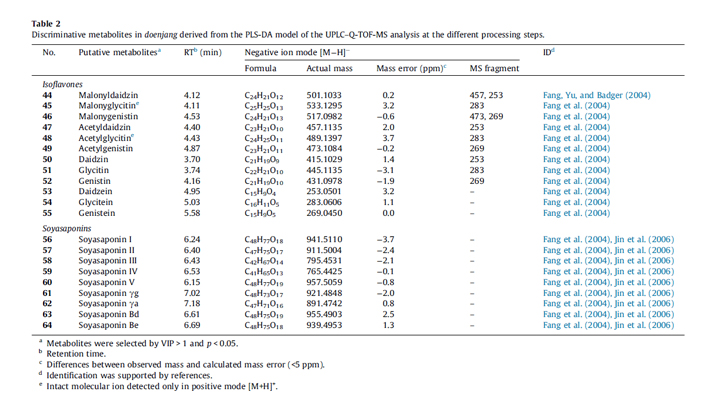Welcome to! Metamass
Fermentation
HOME > Platforms > Fermentation
Fermentation metabolomics (Fungi/Bacteria/Human intenstine)
혈장 분석을 통한 댕댕이, 꾸지뽕 혼합 콩 발효 식품의 항비만 효과 연구
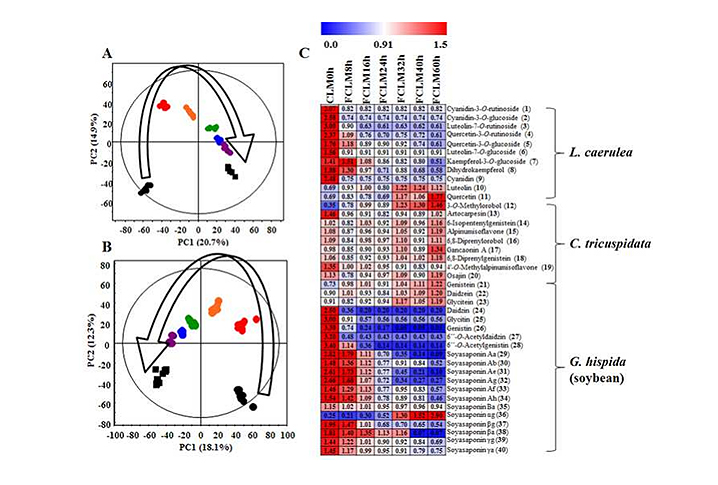
- Fig 2. Principal component analysis (PCA; A: positive mode, B: negative mode) score plots and heatmap (C) derived from UPLC-Q-TOF-MS data on CLM during fermentation; ●CLM0h (unfermented CLM), ●FCLM8h (CLM fermented for 8 h), ●FCLM16h (CLM fermented for 16 h), ●FCLM24h (CLM fermented for 24 h), ●FCLM32h (CLM fermented for 32 h), ●FCLM40h (CLM fermented for 40 h), ■FCLM60h (CLM fermented for 60 h). Each data point shown on the heatmap was normalized by the mean values of each set.
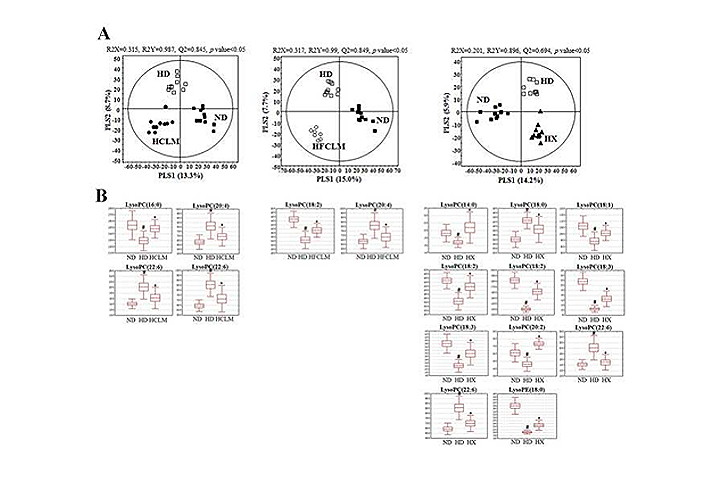
- Fig 6. PLS-DA score plots (A) and box-whisker plots (B) of statistically significant metabolites showing a tendency for restoration as a result of administration of CLM, FCLM, or xenical in the mouse model of high-fat diet (HFD)-induced obesity; ND (normal-diet group), HD (high-fat diet group), HX (HFD with xenical administrated group), HCLM (HFD with CLM administrated group), HFCLM (HFD with FCLM administrated group). The statistical analysis was performed by an independent t test in comparison with the HD group (# p value < 0.05, *p value < 0.05).
Comparison of Metabolites Variation and Antiobesity Effects of Fermented versus Nonfermented Mixtures of Cudrania tricuspidata, Lonicera caerulea, and Soybean According to Fermentation in vitro and in vivo , Suh DH and Lee CH et al., Plos one 2016
산업적 공정으로 제조된 메주의 숙성기간 동안의 대사체 분석
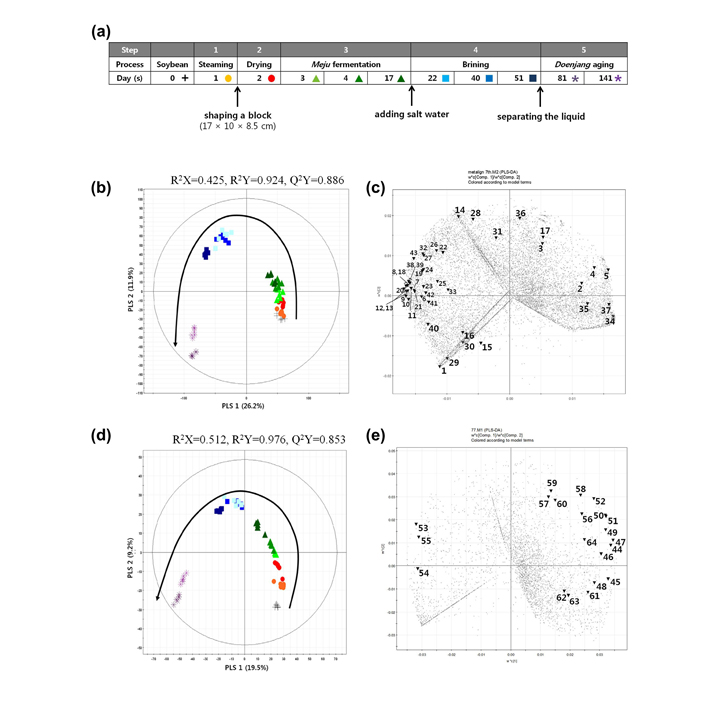
- Fig. 1. Processing method and basic information (pH and salinity) of doenjang (a). PLS-DA score plots and loading plots derived from the GC?TOF-MS (b and c) and UPLC?QTOF - MS (d and e) data sets of doenjang samples collected at different processing steps (soybean, +; steaming and drying, d; meju fermentation, N; brining, j; doenjangaging,?). Plot annotation: 1, lactic acid; 2, malonic acid; 3, succinic acid; 4, malic acid; 5, citric acid; 6, alanine; 7, valine; 8, leucine; 9, isoleucine; 10, proline; 11, glycine; 12, serine; 13, threonine; 14, methionine; 15, aspartic acid; 16, pyroglutamic acid; 17, c-aminobutyric acid; 18, glutamic acid; 19, phenylalanine; 20, glutamine; 21, ornithine; 22, lysine; 23, histidine; 24, tyrosine; 25, glycerol; 26, arabinose; 27, arabitol; 28, fructose; 29, mannose; 30, galactose; 31, glucose; 32, mannitol; 33, inositol; 34, sucrose; 35, maltose; 36, melibiose; 37, raffinose; 38, palmitic acid; 39, linoeic acid; 40, oleic acid; 41, linolenic acid; 42, stearic acid; 43, urcil; 44, malonyldaidzin; 45, malonylglycitin; 46, malonylgenistin; 47, acetyldaidzin; 48, acetylglycitin; 49, acetylgenistin; 50, daidzin; 51, glycitin; 52, genistin; 53, daidzein; 54, glycitein; 55, genistein; 56, soyasaponin I; 57, soyasaponin II; 58, soyasaponin III; 59, soyasaponin IV; 60, soyasaponin V; 61, soyasaponin cg; 62, soyasaponin ca; 63, soyasaponin Bd; 64, soyasaponin Be.
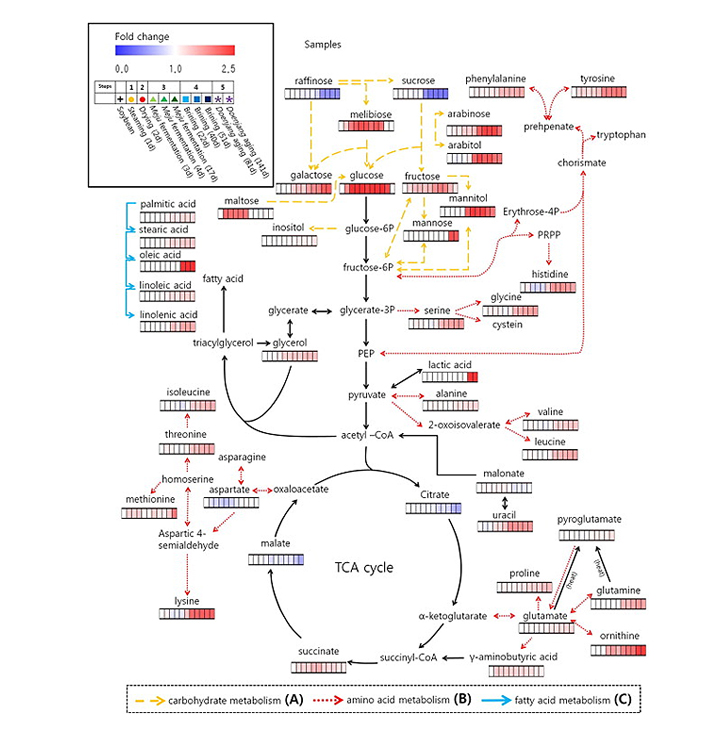
- Fig. 2. Primary metabolite changes of doenjang during processing. (A) carbohydrate metabolism, (B) amino acid metabolism, (C) fatty acid metabolism. Fold changes were calculated (peak area [log10]) as the ratio of each sample to soybeans.
Primary and secondary metabolite profiling of doenjang, a fermented soybean paste during industrial processing,
Lee SY and Lee CH et al., http://dx.doi.org/10.1016/j.foodchem.2014.05.089


